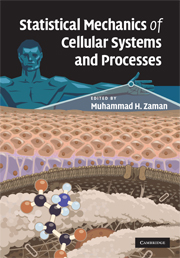Book contents
- Frontmatter
- Contents
- List of contributors
- Preface
- 1 Concentration and crowding effects on protein stability from a coarse-grained model
- 2 Observations on the mechanics of a molecular bond under force
- 3 Statistical thermodynamics of cell–matrix interactions
- 4 Potential landscape theory of cellular networks
- 5 Modeling gene regulatory networks for cell fate specification
- 6 Structural and dynamical properties of cellular and regulatory networks
- 7 Statistical mechanics of the immune response to vaccines
- Index
- Plate section
1 - Concentration and crowding effects on protein stability from a coarse-grained model
Published online by Cambridge University Press: 04 September 2009
- Frontmatter
- Contents
- List of contributors
- Preface
- 1 Concentration and crowding effects on protein stability from a coarse-grained model
- 2 Observations on the mechanics of a molecular bond under force
- 3 Statistical thermodynamics of cell–matrix interactions
- 4 Potential landscape theory of cellular networks
- 5 Modeling gene regulatory networks for cell fate specification
- 6 Structural and dynamical properties of cellular and regulatory networks
- 7 Statistical mechanics of the immune response to vaccines
- Index
- Plate section
Summary
Introduction
Most of what we know about protein folding comes from experiments on polypeptides in dilute solutions [1–4] or from theoretical models of isolated proteins in either explicit or implicit solvent [5–12]. However, neither biological cells nor protein solutions encountered in biopharmaceutical development generally classify as dilute. Instead, they are concentrated or “crowded” with solutes such as proteins, sugars, salts, DNA, and fatty acids [13–15]. How does this crowding affect native-state protein stability? Are all crowding agents created equal? If not, can generic structural or chemical features forecast their effects?
To investigate these and other related questions with computer simulations requires models rich enough to capture three parts of the folding problem: the intrinsic free energy of folding of a protein in solvent, the main structural features of the native and denatured states, and the connection between protein structure and effective protein–protein interactions. The model must also be simple enough to allow for the efficient simulation of hundreds to thousands of foldable protein molecules in solution, which precludes the use of atomistically detailed descriptions of either the proteins or the solvent.
We recently developed a coarse-grained modeling strategy that satisfies these criteria. It is not optimized to describe any specific protein solution. Rather, it is a general tool for understanding experimental trends regarding how concentration or crowding impact the thermodynamic stability of globular proteins.
- Type
- Chapter
- Information
- Publisher: Cambridge University PressPrint publication year: 2009

